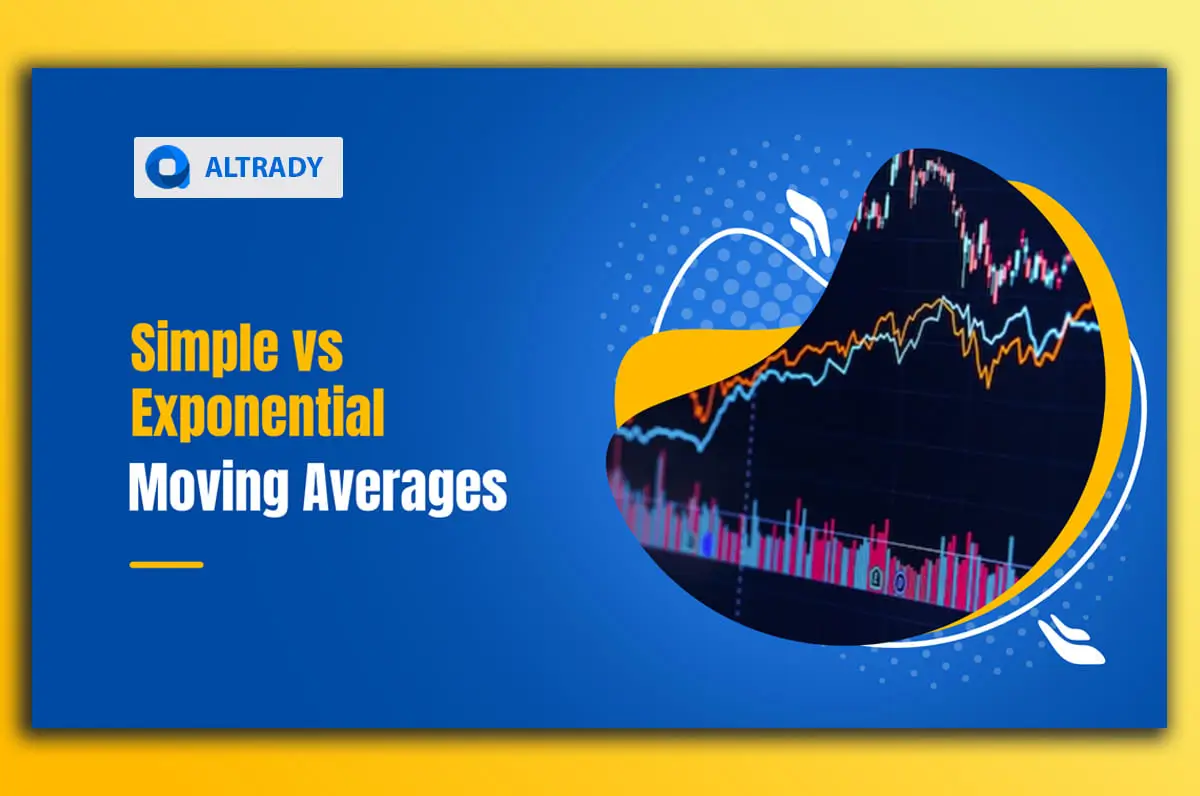Category List
Featured List


Choosing Between Simple & Exponential Moving Averages: A Complete Guide
Intro
Simple Moving Average (SMA) and Exponential Moving Average (EMA) are technical indicators that solve following trends and detect their potential shift points, trace dynamic support and resistance levels by combination with other technical tools. Traders can spot even divergence/convergence or overbought/oversold conditions.
In this article, we encounter SMA and EMA versus each other, resalting their differences, how their calculations work, and mentioning the most used strategies with both.

What is a Simple Moving Average
The Simple Moving Average is a calculation of the price action of an asset that aims to represent the underlying trends of the markets, smoothing out the sharpening movements and fluctuation during a specific timespan.
Typically, SMA works by calculating the closing price during the chosen time frame, but within the options offered for traders by this tool, the calculation can be adjusted for opening prices, making the indicator more versatile and adaptable for the trader' needs.
Meeting specific trading goals and developing custom strategies would require an overview of the formula working behind the SMA.
Calculation: interpreting the formula
So, here is a breakdown of the SMA arithmetic calculation:
- SMA = (price 1 + price 2 + price 3 + ... + price N) / N
Where:
- The sum of "Price 1 and price 2, and so on" represents the quotation of the asset at a specific period.
- The "N" represents the total number of periods established in the moving average settings, like 100-day or 20-day.

What is the Exponential Moving Average
Similarly to the SMA, the Exponential Moving Average (EMA) is an advanced extension of the simple average. This version adds weight to more recent price data for its moving average line calculation and is more responsive to price fluctuations.
Like the SMA, the exponential brings out the underlying trends of a crypto asset. In this case, usually, traders use EMA to seek short-term opportunities while reflecting fast-paced price direction changes.
For the proper utilization of the EMA, we should overview its formula, which is slightly different from the SMA.
Calculation: interpreting the formula
So, here is a breakdown of the EMA arithmetic calculation.
EMA calculates different variants compared to SMA. For an easy understanding, let's first define those variants:
- Closing price (current) = the closing price for the current day period. For example, 26-day.
- EMA = the current EMA value obtained from the previous day period.
- Multiplier = the variant determining how much weight is added to the current price corresponding to the previous EMA
- n = the number of periods calculated, like the SMA.
Once the variants are defined:
Multiplier = 2 / (n + 1)
EMA (current) = (Closing Price (current) x Multiplier) + (EMA (previous) x (1 - Multiplier))

Key Differences: SMA vs EMA
- Simple Moving Average calculates the sum of various prices (closing or opening) divided by the number of periods chosen for the indicator.
- Exponential Moving Average calculates the sum of the product resulting from multiplying the current closing price by the multiplier and the product resulting from multiplying the previous EMA by one minus the multiplier.
- SMA is less sensitive to price changes, making it ideal for long-term analysis.
- EMA is more responsive to rapid price fluctuations, making it outstanding for short-term analysis.
Comparative table of Simple Vs. Exponential calculation
SMA example: Calculating the 10-day period | EMA example: Calculating the 10-day period | ||
|---|---|---|---|
Day | Closing Price | Day | Closing Price |
1 2 3 4 5 6 7 8 9 10 | $20 $22 $21 $23 $25 $24 $22 $20 $19 $18 | 1 2 3 4 5 6 7 8 9 10 | $20 $22 $21 $23 $25 $24 $22 $20 $19 $18 |
SMA (10-day) = ($20 + $22 + $21 + $23 + $25 + $24 + $22 + $20 + $19 + $18) = $218 / 10 SMA = $21.80 | Initially if we take the SMA calculated previously: EMA (Day 1) = $21.80 (initial EMA using 10-day SMA) Then, for day 2: Multiplier = 2 / (10 + 1) = 0.1818 (approximately) Where: EMA (Day 2) = ($22 x 0.1818) + ($21.80 x (1 - 0.1818)) = $3.98 + ($17.84) = $21.82 (approximately) | ||
How SMA and EMA work for Crypto Trading
Regarding crypto trading, choosing between EMA or SMA will depend on your trading goals. You could choose to combine both and combine them with other indicators.
The possibilities are at your disposition and experience. For now, let's point out some popular strategies:
- Crossovers strategy: Whether using EMA or SMA, when the shorter period line is above the longer period line, it emerges as a bullish signal. A bearish signal would be the shorter period going below the longer period.
- Trio strategy: A popular application of both EMA and SMA is plotting three lines in the chart at the same time. Each line represents a period. The most common trio is 50-day, 100-day, and 200-day.
- MACD strategy: MACD is an oscillator indicator that calculates the difference between two EMA values for divergences and convergence signals.
- Using Relative Strength Index (RSI): RSI is another oscillator. It serves for overbought and oversold signals. Spotting an overbought level alongside an EMA or SMA cross-over might indicate a potential trend shift from the upside to the downside.
Conclusion and Call to action
Choosing between SMA or EMA will depend on the trading strategy implemented and the goals pursued.
For short-term crypto traders, perhaps EMA will serve much better, taking advantage of trend momentums and reversal points.
For long-term crypto traders, SMA would be a better option, forecasting strong trend seasons, more relevant dynamic support or resistance level, or for DCA strategies.
In Altrady, you can enjoy a crypto suite full of tools to start testing SMA and EMA strategies. MACD and RSI would be a great complement for strategies developed along Moving Averages, simple or exponential.





























